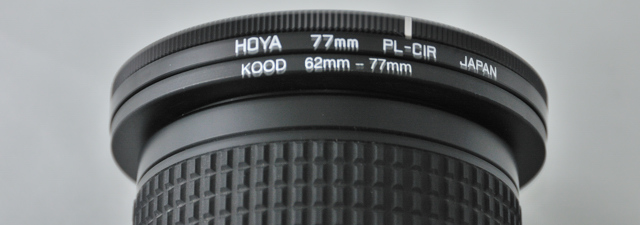Article
Stepping Rings
 
A 62 to 77mm stepping ring allowing a 77mm
polarizer on a 62mm lens.
Lens come in different sizes, both focal
lengths but also in the physical size of the front of the lens. When it comes
to filters and adaptors and other items to the front of a lens using the
filter threads, we could buy a complete set for each size, which would be
both an unnecessary expense and weight to carry, or we can use
stepping rings. Stepping rings allow a different sized filter or attachment
to be used.
|
Stepping rings screw into the filter threads
on the front of the lens and then provide an alternative filter thread in
another size.
You can add more than one stepping ring
together allowing fewer stepping rings to be used to cover a wider range of
lenses.
Stepping rings can step up, or down.
Stepping rings are available from a number of
suppliers including
SpeedGraphic
 and
SRB-Grturn
and
SRB-Grturn
 ,
many others will also list them, they are usually found under
filter or lens accessories. ,
many others will also list them, they are usually found under
filter or lens accessories.
The filter sizes are usually
shown on the lens, with most Nikon lenses its on the underside when the camera
is held with the camera and lens connected and camera held for normal use, and a
number starting with 0 with a line through it.
Generally its said that its
best to have all filters and other items for the largest size lens that you
have, and adapt other lenses up to this. It is possible to adapt down telephoto
lenses and longer standard lenses by around 4mm, but you can't do this with
wider angle lenses as the filter will get into the edge of the shot.
|
 |
As larger filters and the
like tend to be more expensive than smaller ones you may like to first look
at what sizes you have and which items you wish to be able to use on each. For
example its more likely that you would want to be able to use
Neutral density
graduated filters
 on the wider angles used for landscapes and unlikely that you would want to fit
these to a long telephoto lens, an adaptor to use a ring flash or macro
flash would likewise be used only with some lenses. The best way to do
this is to draw a grid, with lenses down the left and filters and attachments
across the top, ticking the combinations that you want to be able to use, also
then double tick those that you are going to use more frequently. You can then
look at the combinations of stepping rings to achieve this and if the multiple
stepping rings will waste too much time for frequently used combinations.
on the wider angles used for landscapes and unlikely that you would want to fit
these to a long telephoto lens, an adaptor to use a ring flash or macro
flash would likewise be used only with some lenses. The best way to do
this is to draw a grid, with lenses down the left and filters and attachments
across the top, ticking the combinations that you want to be able to use, also
then double tick those that you are going to use more frequently. You can then
look at the combinations of stepping rings to achieve this and if the multiple
stepping rings will waste too much time for frequently used combinations.
I could have just one
polarizer,
 but in practice I carry three, One covering the largest size I am likely
to use (not my largest lens), and a second - the most common size I will use the
majority of the time, so its fast to use without stepping rings. The third is a
polarizer that is a part of the Cokin filter system used when I am also using ND
graduated filters. As I often will use more than one camera body, I may have a
need to use more than one filter or system at a time, so have worked out the
combination of items including stepping rings so that I can operate efficiently
without having to carry too much.
but in practice I carry three, One covering the largest size I am likely
to use (not my largest lens), and a second - the most common size I will use the
majority of the time, so its fast to use without stepping rings. The third is a
polarizer that is a part of the Cokin filter system used when I am also using ND
graduated filters. As I often will use more than one camera body, I may have a
need to use more than one filter or system at a time, so have worked out the
combination of items including stepping rings so that I can operate efficiently
without having to carry too much.
Adaptors are used with filter holder
systems like the Lee and Cokin systems. These allow a single
filter holder
 to be used and only the adaptor changed
to fit the filter thread to the filter holder. For example if you have 4
different sized lenses you would conceptually need 4 adaptors. If you have
two filter systems in use and 4 lenses then you would need 8. Stepping rings
can be used to reduce the number of adaptors required.
to be used and only the adaptor changed
to fit the filter thread to the filter holder. For example if you have 4
different sized lenses you would conceptually need 4 adaptors. If you have
two filter systems in use and 4 lenses then you would need 8. Stepping rings
can be used to reduce the number of adaptors required.
See also:
Filter
Section
 for more articles.
for more articles.
|